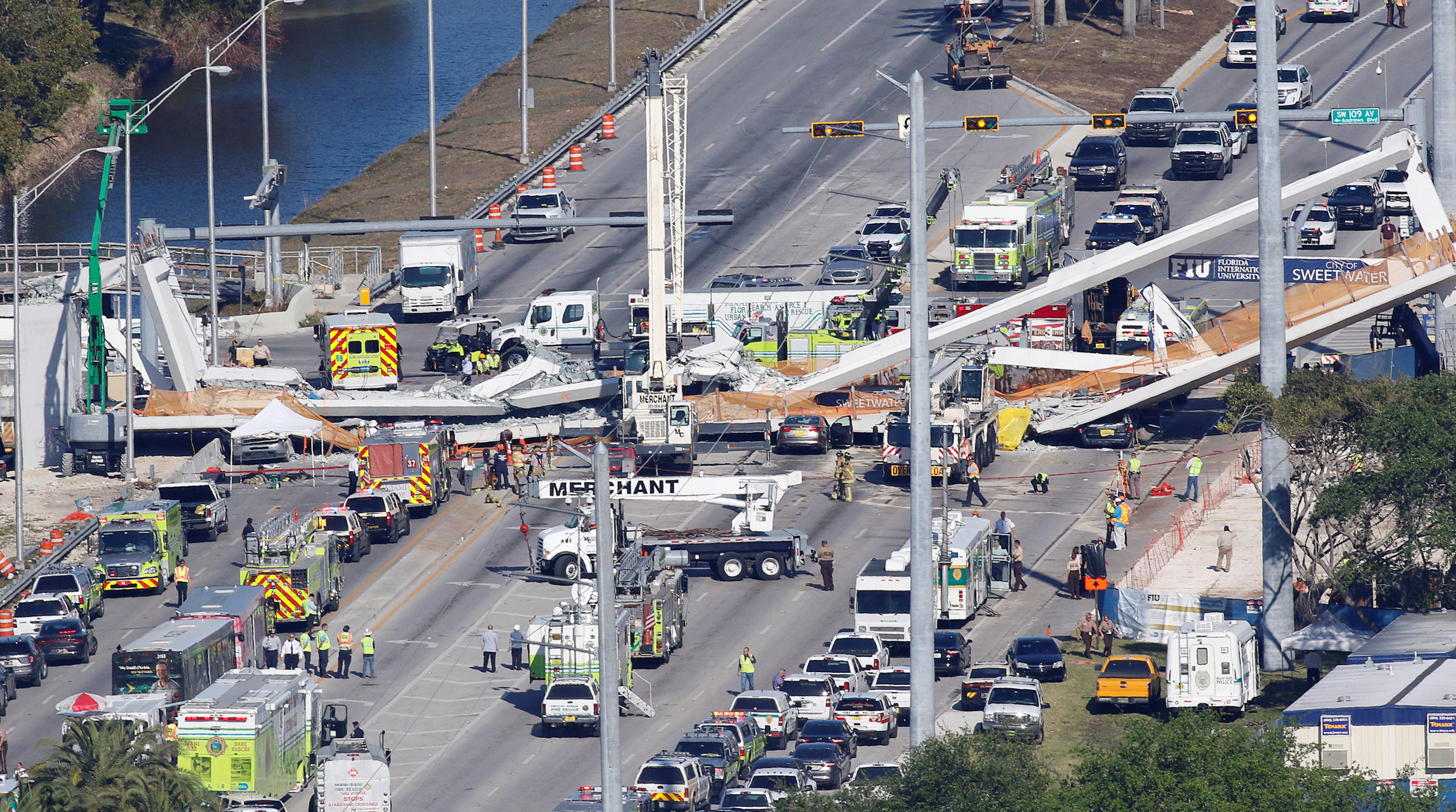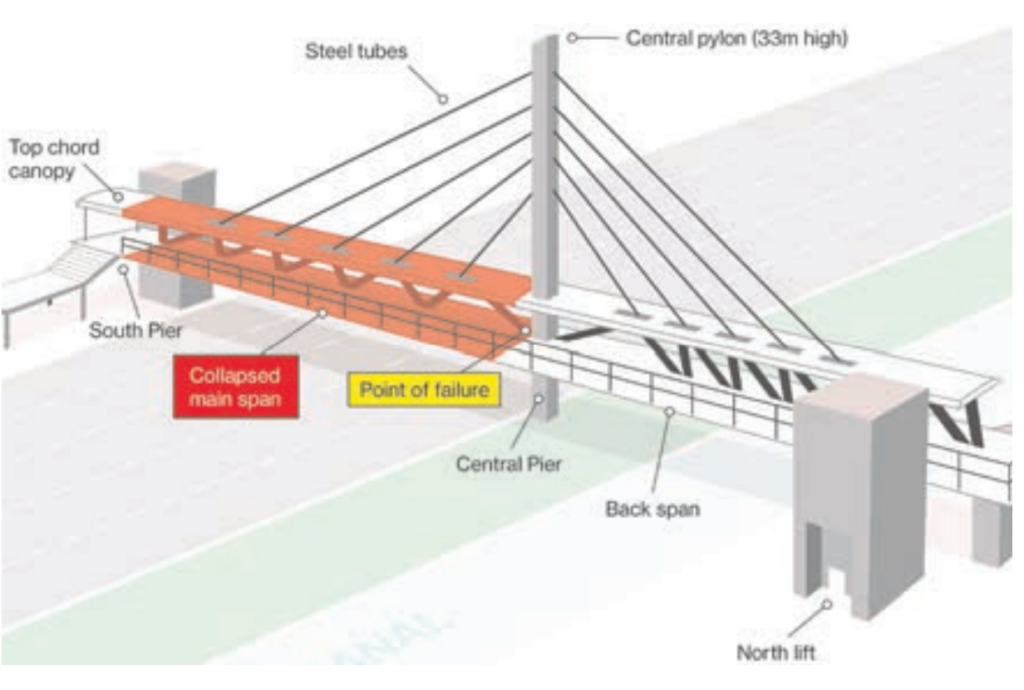This article presents the NTSB investigations into the 2018 Pedestrian Bridge Collapse in Florida and the lessons learnt from the failure

On March 15, 2018, tragedy struck in Miami, Florida, when a newly installed pedestrian bridge at Florida International University (FIU) collapsed, killing six people and injuring ten others (See featured image). The incident, which occurred just days after the bridge was put in place, shocked the nation and raised serious questions about the safety protocols and construction practices in infrastructure projects.
This article delves into the causes of the collapse, its aftermath, and the crucial lessons learned to prevent such disasters in the future.
The Collapse: What Happened?
The FIU pedestrian bridge was intended to provide a safe crossing over a busy highway for students and pedestrians. The innovative design of the bridge featured a single concrete span supported by cables, which was installed using Accelerated Bridge Construction (ABC) techniques. ABC is a popular method aimed at reducing on-site construction time and minimizing traffic disruption.
This was a bridge of an unusual design and was being constructed in an unusual manner – a bespoke reinforced concrete post-tensioned structure (Figure 1). This comprised two spans, one with a 53m long reinforced concrete truss main span and a similar, but shorter, second span. The self-supporting pylon and steel tubes are non-structural architectural features.

The first span was cast off-site and transported into position by a self-propelled modular transporter (SPMT). During the lift, the end diagonals, cantilevered from the inboard SPMT supports, were in tension and had to be post-stressed to revert them to compression during this temporary stage.
Once the main span was settled onto the supports, the end diagonals returned to compression in their permanent state, and the tension rods were destressed. However, as soon as the bridge bore its own weight, cracks emerged at the nodes. Over the following 19 days, these cracks widened until the bridge ultimately collapsed.
The construction and inspection firms involved were aware of the cracks and reported them to the design firm, seeking guidance. For this design-and-build contract, the engineer of record (EOR) inspected the cracks. According to the National Transportation Safety Board (NTSB) report, the EOR consistently indicated that the cracks posed no safety threat.
On the morning of the collapse, a decision was made to re-tension the bars in the distressed diagonal under compression, leading to further compression. On Thursday, March 15, 2018, during this re-tensioning operation, the main span collapsed onto a live road. At the time of the collapse, only two of the eight traffic lanes were closed. Eight vehicles, stopped at traffic lights below the bridge, were fully or partially crushed. One bridge worker and five vehicle occupants lost their lives, and ten people were injured. Investigations would commence immediately.
Causes of Failure and Lessons Learnt
As has always been the case and has it continues to be the case, no structural failure arises from technical factors alone, but from a combination of technical and human factors.
Following the collapse, the National Transportation Safety Board (NTSB) conducted a thorough investigation to determine the root causes of the disaster. The investigation revealed multiple contributing factors, including design flaws, inadequate peer review, and communication breakdowns among the involved parties.
Design Flaw
As the NTSB would come to find out and present in their report, the cause of the collapse was the bridge’s structural deficiencies. The NTSB pointed out that there was an underestimation of loads and an overestimation of capacity, with incorrect loads and load factors being used. These design issues resulted in a node that couldn’t resist the shear force, leading to distress in the bridge members that couldn’t handle the forces.
The NTSB also reported that the peer-review process was inadequate. The checker was only contracted to review the finished structure, not the structure during construction. The review of cracks and changes to the tensioning procedure were not subjected to peer review.
Additionally, it is highly likely that the location of service voids, placed too close to the failed node, contributed to the collapse, as these were apparently not considered in the design. It’s crucial that non-structural service voids are placed only with the written permission of the structural designer to ensure the structural strength is adequately considered.
Design Check and Category Verification
The NTSB would further find that the design process lacked a rigorous independent peer review. A thorough review by an experienced engineering firm could have identified the design flaws and prevented the collapse.
In Florida, structural peer reviews aim to provide independent verification that a structural design generally conforms to governing requirements. In this case, the American Association of State Highway and Transportation Officials’ (AASHTO) LRFD Bridge Design Specifications and the Florida Department of Transportation’s specifications, protocols, and guidelines apply.
In other jurisdictions, this process is similarly referred to as a “design check.” The necessity for appropriate levels of design check categories for infrastructure development is well established for example, in the other jurisdiction. Typically, complex or unusual designs, those involving significant departures from current standards, or novel methods of analysis, or those requiring considerable engineering judgment, require Category 3 design checks.
It is recommended that a multidisciplinary team—including the principal designer, designer, principal contractor (PC), and client—review the design check category for both permanent and temporary works. This review should consider the potential need to upgrade the design check category of temporary works, which involve permanent works in temporary conditions, to the same category as the permanent works. Importantly, any changes to the agreed sequencing of installation must be both designed and checked prior to execution.
Site Supervision and Independent Checking of Execution of the Works
There were significant lapses in communication between the engineering firm, FIGG Bridge Engineers, and the contractor, Munilla Construction Management (MCM). Despite noticing the cracks, the engineering team did not adequately communicate the severity of the issue to the construction team, nor did they halt work to address the problem.
In Florida (and other parts of the USA), the Engineer of Record (EOR) is a professional engineer responsible for preparing, signing, dating, sealing, and issuing any engineering documents for engineering services or creative work.
There might not be a direct equivalent position in modern contract procurement in other jurisdictions. However, there is a similarity with more traditional forms of procurement where a resident engineer would be appointed to undertake similar tasks, or a clerk of works would be appointed for an independent overview.
In other jurisdiction, numerous examples exist, where a designer hands over a pack of construction information to the principal contractor (PC) before execution and is no longer involved. A preferred collaborative working arrangement involves the designer being present on-site to expedite design decisions and relay design intent, improving outcomes for all parties.
It is this writer’s view that, in similar circumstances, a representative from the designer’s organization must attend the site. Their presence ensures construction aligns with the design, facilitates clear communication of the design intent, allows for expeditious dialogue to address changes, and acts as an independent observer to improve quality and spot potential errors. Such interventions provide a level of independence and ensure appropriately skilled personnel on-site can see things that the untrained eye might miss.
These measures would incur minimal additional costs but would result in significant gains for all parties involved.
Construction Oversight
Finally, the NTSB in his report criticized the decision to adjust the tension in the support cables without first addressing the observed cracks.
All parties failed to recognize the imminent danger of the bridge during inspections conducted hours before the collapse. The construction engineer and inspector did not classify the cracks as structurally significant. In hindsight, the severity of the cracks should have warranted the immediate closure of the road and support of the truss to reduce loads while awaiting further evaluation.
The evaluation of the cracks and the decision to re-tension the diagonal member, made by the Engineer of Record (EOR), represented a change from the original design. This change should have undergone an independent design check.
Additionally, the design-and-build contractor did not exercise its own independent professional judgment to close the road.
Lessons Learnt
In addition to the above recommendations made in above sections. CROSS suggests the following as general measures when dealing with projects of such nature:
Contingency Planning: Projects should engage in “what if” contingency planning, considering potential problems and how to prevent or mitigate them. For example, the Florida bridge collapse could have been prevented by considering the consequences of the developing cracks over several weeks.
Monitoring Cracks: Any increase in crack width, especially those occurring over a short period, must be taken seriously and evaluated by an expert.
Engineering Decisions by Non-Engineers: The fragmented nature of the industry often leads to engineering decisions being made by non-engineers without consulting competent engineers. This results in significant safety risks because non-engineers may not understand the implications of their decisions. The industry must recognize this serious issue and find ways to prevent it.
Designer Input and Supervision: Design-and-build contract procurement methodologies need to ensure that an appropriate level of designer input and supervision is present on-site to guarantee quality and safety.
Aligning Procurement Strategy: Projects should ensure that their procurement strategy and contracts are aligned with the competence of those involved and the complexity of the work.
Training Engineers: Engineers should be trained to recognize early warnings of failure through learning and experience.
Ensuring Competency: The industry must do more to ensure the competency of individuals and companies is demonstrated.
Conclusion
This article highlights the key lessons from the Florida bridge collapse. The incident resulted from a complex series of unfortunate events, but one fact stands out: the warning signs of distress were evident, and the traffic beneath the bridge could and should have been halted as a precaution.
The decisions made on the day of the collapse, which deviated from the approved design and were unchecked, exacerbated the situation. This preventable tragedy must be thoroughly examined, and the above recommendations should be implemented by all organizations involved in the construction industry.
Also See: The I-35W Bridge Failure – Another Instance of Implicit Assumptions
Sources & Citations
- National Transportation Safety Board. Investigative Update: Collapse of Pedestrian Bridge Under Construction, Miami, Florida (HWY18MH009)
- CROSS Safety Alert (2024). Lessons from the 2018 Florida Collapse During Construction. www.cross-safety.org/us/safety- information/cross-safety-alert/ lessons-learned-2018-florida- bridge-collapse-during. (Accessed: June 2024).